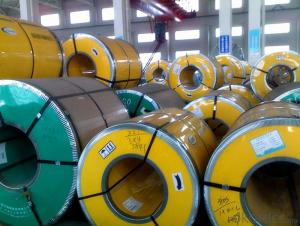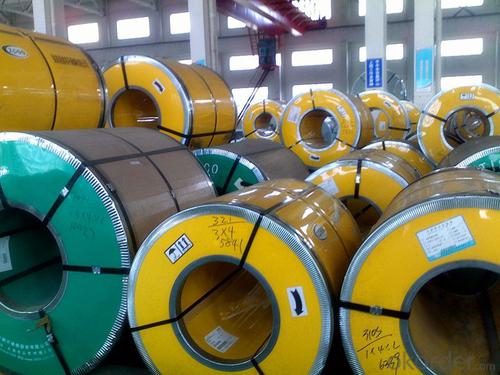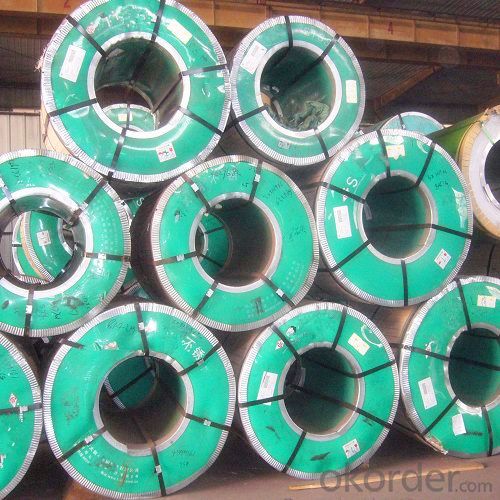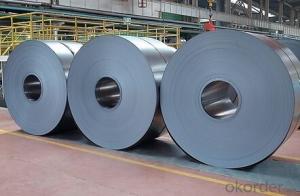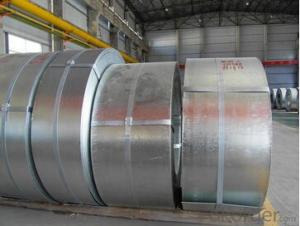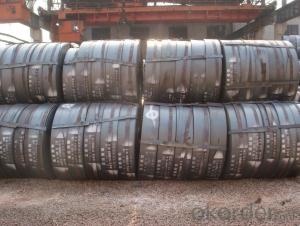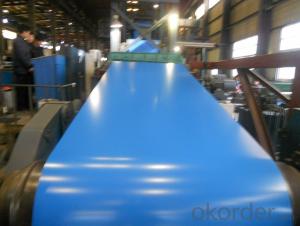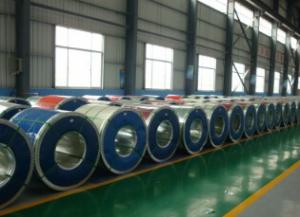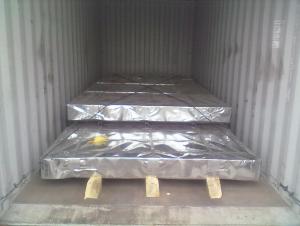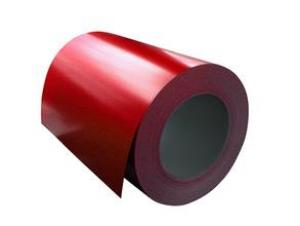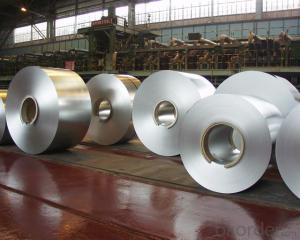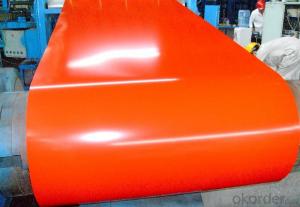Prepainted Zinc/aluzinc Steel Sheet In Coils
- Loading Port:
- Tianjin
- Payment Terms:
- TT OR LC
- Min Order Qty:
- 25 m.t.
- Supply Capability:
- 10000 m.t./month
OKorder Service Pledge
OKorder Financial Service
You Might Also Like
Prepainted Zinc/aluzinc Steel Sheet In Coils
1.Structure of Prepainted Zinc/aluzinc Steel Sheet In Coils
Structure of Prepainted Zinc/aluzinc Steel Sheet In Coils are coated with organic layer, which provides higher anti-corrosion property and a longer lifespan than that of galvanized steel sheets.
2. The base metals for Color Coated Steel Coil consist of cold rolled, HDG electro-galvanized and hot-dip alu-zinc coated steel. The finish coats of Color Coated Steel Coil can be classified into groups as follows: polyester, silicon modified polyesters, polyvinylidene fluoride, high-durability polyester, etc.
3. The production process has evolved from one-coating-and-one-baking to double-coating-and-double-baking, and even three-coating-and-three-baking.
4. The color of the Color Coated Steel Coil has a very wide selection, like orange, cream-colored, dark sky blue, sea blue, bright red, brick red, ivory white, porcelain blue, etc.
5. The Color Coated Steel Coil can also be classified into groups by their surface textures, namely regular prepainted sheets, embossed sheets and printed sheets.
2.Main Features of Prepainted Zinc/aluzinc Steel Sheet In Coils.
1) Rust-proof
2) Water-proof
3)Durable using
3. Prepainted Zinc/aluzinc Steel Sheet In Coils Images
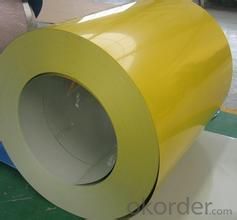

4. Prepainted Zinc/aluzinc Steel Sheet In Coils Specification
goods | Prepainted Zinc/aluzinc Steel Sheet In Coils |
Technical Standard: | JIS 3302 / ASTM A653 / EN10143/EN10327 |
Grade | DX51D / DX52D/ DX53D/ S250,280,320GD |
Width | 500/650/726/820/914/1000/1200/1219/1220/1250mm |
Thickness | 0.17-1.6mm (0.25-0.45mm is the most advantage thickness) |
Type of coating: | galvanized |
Zinc coating | Z60-120g/m2 |
Surface treatment | chromed / skin pass/ oiled /un oiled /slightly oiled/ dry |
Surface structure: | zero spangle / minimized spangle / regular spangle/ big spangle |
| MOQ | 5 Tons |
Package: | Properly packed for ocean freight exportation in 20''containers |
Price terms | FOB,CFR,CIF,CPT.CNF,CIP |
Payment terms | 30%TT in advance+70% TT or irrevocable 70%L/C at sight |
delivery time | 7days after receipt of 30% TT |
5.FAQ of Prepainted Zinc/aluzinc Steel Sheet In Coils
We have organized several common questions for our clients,may help you sincerely:
①How about your company?
A world class manufacturer & supplier of castings forging in carbon steel and alloy steel,is one of the large-scale professional investment casting production bases in China,consisting of both casting foundry forging and machining factory. Annually more than 8000 tons Precision casting and forging parts are exported to markets in Europe,America and Japan. OEM casting and forging service available according to customer’s requirements.
②How to guarantee the quality of the products?
We have established the international advanced quality management system,every link from raw material to final product we have strict quality test;We resolutely put an end to unqualified products flowing into the market. At the same time, we will provide necessary follow-up service assurance.
③What is the usage on the products?
The industrial use
The application field | example illustration |
The electrical appliance industry | Air conditioner,Computer chassis, Plate for refrigerator,Outer shell of washing machine,kitchen fittings, The freezing chamber device |
The building industry | housetop,Lateral wall,doors and windows, gutter,Shutter doors and windows,Wall frame , Ceiling joist,ventiduct |
The agricultural and pastoral | Granary,silo,animal house,trough,flume,Greenhouse trellis,Baking equipment; |
The transport | railroad:The roof of the train,The internal frame of train,The road sign,The inner walls of the train; |
The equipment and structure | radiator,cold roll-formed ,Pedals and rack |
- Q: How are steel strips used in automotive industry?
- Steel strips are used in the automotive industry for a variety of purposes, including the manufacturing of car bodies, chassis, and other structural components. These strips are often formed, bent, and welded to create the desired shape and strength required for different automotive parts. Additionally, steel strips are used in the production of springs, fasteners, and other mechanical components that are crucial for the proper functioning of vehicles.
- Q: What are the factors that affect the weldability of steel strips?
- Several factors can affect the weldability of steel strips, including the chemical composition of the steel, the presence of impurities or contaminants, the thickness and surface condition of the strips, the welding method used, and the heat input during the welding process. Additionally, the presence of residual stresses, the welding procedure employed, and the skill and experience of the welder can also influence the weldability of steel strips.
- Q: What are the different welding techniques used for steel strips?
- There are several different welding techniques that can be used for steel strips, depending on the specific application and desired results. 1. Arc Welding: This is a common method used for steel strip welding, where an electric arc is created between an electrode and the workpiece. This process can be further categorized into different types such as shielded metal arc welding (SMAW), gas metal arc welding (GMAW), and gas tungsten arc welding (GTAW). Arc welding provides a strong and durable bond between steel strips. 2. Resistance Spot Welding: This technique involves applying pressure and heat to the steel strips at specific points using electrodes. The electric current passes through the strips, causing them to fuse together. Resistance spot welding is often used in automotive and manufacturing industries due to its speed and efficiency. 3. Laser Welding: Utilizing a high-powered laser beam, this technique melts and fuses the steel strips together. Laser welding offers precise control and minimal heat input, making it suitable for thin steel strips or applications that require high precision. 4. Electron Beam Welding: Similar to laser welding, electron beam welding uses a focused beam of electrons to melt and join the steel strips. This technique is particularly effective for welding thin strips or materials with high melting points. 5. Friction Stir Welding: This innovative technique involves a rotating tool that generates friction and heat between the steel strips, effectively joining them together. Friction stir welding is commonly used for aluminum and other non-ferrous metals but can also be adapted for steel strips. Each welding technique has its own advantages and limitations, and the choice depends on factors such as the thickness of the steel strips, desired strength, joint configuration, and production requirements. It is important to consider these factors and consult with welding experts to determine the most suitable technique for specific steel strip welding applications.
- Q: How are steel strips coated for protection?
- Steel strips are coated for protection through a process called galvanization. Galvanization involves applying a layer of zinc to the surface of the steel strips. This is done by either hot-dip galvanizing or electroplating. In hot-dip galvanizing, the steel strips are immersed in a bath of molten zinc at a temperature of around 450°C (842°F). The zinc reacts with the steel, forming a protective layer of zinc-iron alloy on the surface. This layer provides excellent corrosion resistance and protects the steel from rusting. Electroplating, on the other hand, involves immersing the steel strips in an electrolyte solution containing zinc ions. A direct electric current is then passed through the solution, causing the zinc ions to bond with the steel surface. This creates a thin but durable layer of zinc coating that safeguards the steel from corrosion. Both hot-dip galvanizing and electroplating provide effective protection for steel strips. The zinc coating acts as a barrier, preventing moisture and corrosive elements from reaching the steel surface. Additionally, even if the coating gets scratched or damaged, the sacrificial properties of zinc ensure that it corrodes first, protecting the underlying steel. Overall, steel strips are coated for protection using galvanization techniques, which involve the application of a zinc layer. This process significantly enhances the durability and longevity of the steel, making it more resistant to corrosion and extending its lifespan.
- Q: How are steel strips processed for slitting into narrower widths?
- Steel strips are processed for slitting into narrower widths through a series of mechanical operations. The first step in the process is to uncoil the steel strip from a large coil and feed it into a slitter machine. The slitter machine consists of multiple circular blades that are spaced apart according to the desired width of the final strips. As the steel strip passes through the slitter machine, the circular blades rotate and cut the strip into narrower widths. The distance between the circular blades determines the width of each individual strip. The slitter machine also has a tensioning system that ensures the steel strip remains taut throughout the process, preventing any buckling or creasing. Once the steel strip has been slit into narrower widths, it goes through a series of other processes to further refine and finish the strips. These processes may include edge trimming, where any uneven or rough edges are trimmed off to achieve smooth and precise edges. The strips may also be leveled to remove any residual stresses and ensure flatness. After all the necessary processing steps, the narrower steel strips are recoiled and packaged for shipment or further processing. The slitting process allows for the production of multiple narrower strips from a single large coil, which increases the versatility and usability of the steel in various applications. Overall, the processing of steel strips for slitting into narrower widths involves precise cutting, edge trimming, leveling, and recoiling to produce strips that meet specific width requirements and quality standards.
- Q: What are the different surface embossing techniques for steel strips?
- There are several different surface embossing techniques for steel strips, including roll embossing, diamond-pattern embossing, brushed embossing, and heat embossing. Each technique creates a unique texture or pattern on the surface of the steel strip, providing aesthetic appeal and enhancing its functionality in various applications.
- Q: What are the different methods for welding steel strips?
- There are several different methods for welding steel strips, each with its own advantages and applications. Some of the most common methods include: 1. Arc Welding: This is a popular method that uses an electric arc to create heat and melt the steel strips. There are different types of arc welding, such as Shielded Metal Arc Welding (SMAW), Gas Metal Arc Welding (GMAW), and Flux-Cored Arc Welding (FCAW). These methods are versatile and can be used for various thicknesses of steel strips. 2. TIG Welding: Tungsten Inert Gas (TIG) welding is another commonly used method for welding steel strips. It involves using a non-consumable tungsten electrode to create the arc, and a separate filler material is added if needed. TIG welding provides high-quality and precise welds, making it ideal for thin steel strips and critical applications. 3. MIG Welding: Metal Inert Gas (MIG) welding is a semi-automatic method that uses a consumable wire electrode and an inert gas to shield the weld pool. It is a relatively fast and efficient process, making it suitable for welding steel strips in industrial applications. 4. Laser Welding: Laser welding is a non-contact method that uses a high-powered laser beam to melt and join the steel strips. It offers precise control and minimal heat input, resulting in a narrow and clean weld. Laser welding is commonly used for thin steel strips in industries such as electronics and automotive. 5. Resistance Welding: Resistance welding utilizes the resistance generated from passing an electric current through the steel strips to create heat and join them. There are different types of resistance welding, including spot welding, seam welding, and projection welding. This method is often used in the automotive industry for joining steel strips together. 6. Plasma Arc Welding: Plasma arc welding is a variation of TIG welding that uses a focused plasma arc to melt the steel strips. It offers a higher energy density than conventional TIG welding, allowing for faster welding speeds and deeper penetration. Plasma arc welding is commonly used for thicker steel strips and in industries such as aerospace and shipbuilding. Overall, the choice of welding method for steel strips depends on factors such as the thickness of the strips, the desired quality of the weld, and the specific application requirements. Each method has its own unique advantages and should be selected based on the specific needs of the project.
- Q: What are the physical properties of steel strips?
- Steel strips have several physical properties that make them desirable for a wide range of applications. Firstly, steel strips are known for their high strength and durability. This is due to the inherent strength of the steel material itself, which allows the strips to withstand heavy loads and resist deformation. The strong nature of steel strips makes them suitable for use in structural applications where strength is crucial, such as in construction and manufacturing industries. Additionally, steel strips have excellent ductility, meaning they can be easily stretched or bent without breaking. This property allows for greater flexibility in the design and fabrication of various products. Steel strips can be formed into different shapes and sizes, making them highly versatile and adaptable to different manufacturing processes. Steel strips also have good thermal conductivity, which means they can efficiently transfer heat. This property is particularly important in applications where heat needs to be dissipated or transferred, such as in heat exchangers or electrical components. The high thermal conductivity of steel strips ensures that heat is effectively spread and dispersed, preventing overheating and potential damage. Furthermore, steel strips exhibit a high melting point, making them resistant to heat and fire. This characteristic is crucial in applications where materials are subjected to extreme temperatures, such as in aerospace or automotive industries. Steel strips can withstand high temperatures without losing their structural integrity, ensuring the safety and reliability of the products they are used in. Lastly, steel strips are generally corrosion-resistant, particularly when they are coated with protective finishes. This property allows the strips to be used in outdoor or corrosive environments without experiencing significant degradation. The corrosion resistance of steel strips ensures their longevity and durability, reducing the need for frequent maintenance or replacement. In summary, the physical properties of steel strips include high strength, good ductility, excellent thermal conductivity, high melting point, and corrosion resistance. These properties make steel strips a preferred material for a wide range of applications, including construction, manufacturing, heat transfer, and more.
- Q: How are steel strips used in the production of pipes and tubes?
- The production of pipes and tubes relies heavily on steel strips, which serve as a vital component. These strips act as the raw material and undergo various manufacturing processes to achieve the desired shape and size. To begin with, the steel strips are unwound and introduced into a forming machine, where they undergo a continuous bending process. This process entails passing the strips through a sequence of rollers, gradually shaping them into a cylindrical form. By adjusting the distance between the rollers, control can be exerted over the diameter and thickness of the pipes or tubes. Once the strips have taken on the desired shape, they are joined together along their length to create a seamless or welded connection. For seamless pipes, the ends of the strip are subjected to high-frequency induction welding or electric resistance welding techniques, causing them to be heated and fused together. Conversely, welded pipes are formed by welding the edges of the strip using various methods, such as high-frequency induction welding, electric arc welding, or submerged arc welding. Following the welding process, additional steps may be taken to enhance the properties of the pipes or tubes. These steps can include heat treatment, surface treatment, or sizing, all of which are carried out to meet specific requirements, such as strength, durability, corrosion resistance, or aesthetic appearance. In summary, steel strips play a crucial role in the production of pipes and tubes by serving as the foundational material that is shaped and welded to achieve the desired shape and size. The versatility and strength of steel make it an ideal choice for pipes and tubes in a wide range of industries, including construction, infrastructure, oil and gas, automotive, and manufacturing.
- Q: What are the different surface texturing techniques for steel strips?
- There are several surface texturing techniques for steel strips, including embossing, etching, brushing, and coating. Embossing involves creating raised patterns or designs on the surface of the steel through the use of pressure and heat. Etching involves chemically removing a layer of the steel surface to create a textured pattern. Brushing involves using abrasive brushes or pads to create a brushed or satin finish on the steel. Coating techniques involve applying a layer of material onto the steel surface to create a textured or patterned effect.
Send your message to us
Prepainted Zinc/aluzinc Steel Sheet In Coils
- Loading Port:
- Tianjin
- Payment Terms:
- TT OR LC
- Min Order Qty:
- 25 m.t.
- Supply Capability:
- 10000 m.t./month
OKorder Service Pledge
OKorder Financial Service
Similar products
Hot products
Hot Searches
Related keywords
